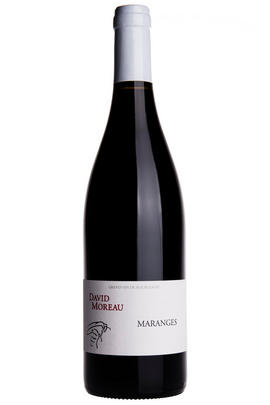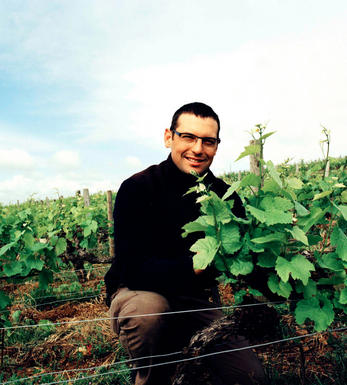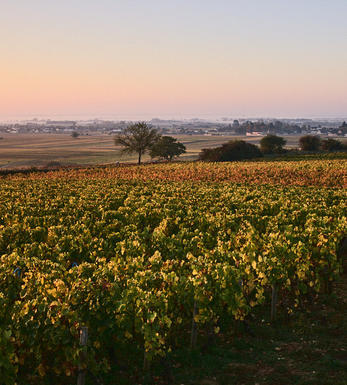
2022 Maranges, Aux Gryphées, David Moreau, Burgundy

Critics reviews
A pretty mid-purple colour with a light oaking to the nose, but above all a really charming fruit, poised, delivering a great fruit-to-acid balance and a light salinity alongside the fresh raspberry fruit. 15% whole bunch vinification here.
Drink 2025 - 2030
Jasper Morris MW, Inside Burgundy (November 2023)
The 2022 Maranges Aux Gryphées contains two parcels, one from the Premier Cru of Clos Rousseau. The attractive bouquet is quite “mellow” in style, a mixture of red and black fruit with hints of sea spray. The palate is medium-bodied with quite a firm structure, the 15% whole bunches lending a subtle pepperiness. This is quite “serious” on the finish and will benefit from a couple of years in bottle.
“The vines were stressed by the drought as we expected to pick around August 23 according to the flowering date,” winemaker David Moreau explains in his barrel cellar, where I am about to taste his 2022s. “But by July and August, the vines were staying green. Nevertheless, I feel it still stopped the maturation. There was no damage to the fruit, but the ripeness was affected. We finally decided to start picking on August 30 for the whites and September 2 for the reds as the forecast was for cooler weather, plus there were light showers that helped to swell the shrivelled berries. This gave us more freshness. We did a 17 to 23-day cuvaison with no acidification, yields between 40hL/ha and 45hL/ha for the Premier Crus. We have low-vigour vines with de-budding early in the season to avoid green harvesting.
We used less new oak in 2022, between 15% and 25%, depending on the cuvée. Bottling will be done at the end of January, so it’s 12 months in barrel and 4 to 5 months in tank. I think the wines are powerful, quite strong, but not too tannic. They have good substance, so they need a bit of ageing.” What can I say? It was an exemplary set of wines that I really enjoyed from start to finish. Check out Moreaus, two brilliant Santenays from Beauregard and Clos des Mouches, and then wonder why the heck you splashed out all that money on that expensive Gevrey or Vosne-Romanée. He has a deft touch in the craftsmanship of winemaking, which is evident in nearly all his wines.
Drink 2026 - 2036
Neal Martin, Vinous.com (January 2024)
About this WINE

David Moreau
David Moreau has taken over part of his octogenerian grandfather’s wine domaine in Santenay in Côte de Beaune, beginning with the 2009 vintage. Prior to that David has worked with Olivier Lamy and Domaine de la Romanée Conti, as well as doing a stage in New Zealand at Neudorf.
David is beginning with 5 of the family’s 9 hectares and suffice to say that significant changes in both viticulture and vinification have been made compared to the ancien regime. The vineyards were almost all planted in the 1960s, so David has old vines to work with. They are mostly pruned by cordon royat to minimise vigour, and the land is either ploughed or left with grass depending on the circumstance of a given plot.

Maranges
Maranges is the southernmost wine appellation of the Côte de Beaune and not as well known as it deserves to be for its robust red wines. The AC only came into existence in 1989 with the amalgamation of the villages of Cheilly, Dezize and Sampigny.
- 140 hectares of village Maranges.
- 100 hectares of premier cru vineyards (20 in all). Best vineyards include La Fussière
Though a very small amount of white wine is made, the lion’s share is Pinot Noir – firm, sturdy wines which need a gentle hand to manage the fruit. Normally drunk best at three to five years old.
Recommended Producers:
Contat Grangé, and Camille Giroud who has made a speciality out of Marange wine since 2004

Pinot Noir
Pinot Noir is probably the most frustrating, and at times infuriating, wine grape in the world. However when it is successful, it can produce some of the most sublime wines known to man. This thin-skinned grape which grows in small, tight bunches performs well on well-drained, deepish limestone based subsoils as are found on Burgundy's Côte d'Or.
Pinot Noir is more susceptible than other varieties to over cropping - concentration and varietal character disappear rapidly if yields are excessive and yields as little as 25hl/ha are the norm for some climats of the Côte d`Or.
Because of the thinness of the skins, Pinot Noir wines are lighter in colour, body and tannins. However the best wines have grip, complexity and an intensity of fruit seldom found in wine from other grapes. Young Pinot Noir can smell almost sweet, redolent with freshly crushed raspberries, cherries and redcurrants. When mature, the best wines develop a sensuous, silky mouth feel with the fruit flavours deepening and gamey "sous-bois" nuances emerging.
The best examples are still found in Burgundy, although Pinot Noir`s key role in Champagne should not be forgotten. It is grown throughout the world with notable success in the Carneros and Russian River Valley districts of California, and the Martinborough and Central Otago regions of New Zealand.


Buying options
Add to wishlist
Description
The vines are old, planted in 1943 and 1947. The latter is Premier Cru, forming about half the blend. This is brightly fruited, with a crunchy, spicy character that makes it very drinkable. The stems soften the tannins and sweeten the mid-palate, and there’s a lovely refreshing grip to the finish.
Drink 2025 - 2032
Berry Bros. & Rudd
wine at a glance
Delivery and quality guarantee